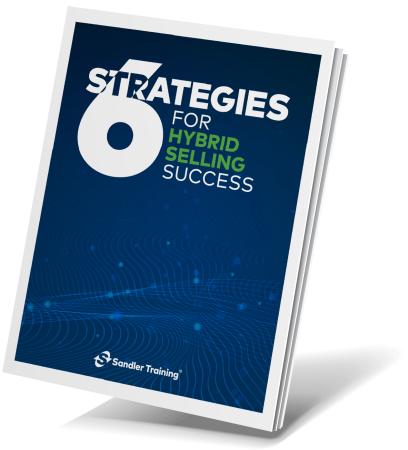
One of the most powerful ideas for maximizing team sales productivity is surprisingly simple: “Don’t buy back tomorrow what you sold today.”
At Sandler, we believe that sales process and methodology should be consistent across all seller roles. Different parts of the sales team learning and executing different approaches result in a siloed strategy. That not only wastes resources, but also sends inconsistent signals to clients and customers, and it undermines the customer experience. It's not a great idea in a buying environment where decision-makers are, broadly speaking, less and less inclined to engage with salespeople in the first place!
We tell our clients that today’s sellers must expect to create a ten-fold increase in client-facing activity to create or sustain a market advantage. What kind of client-facing activity? Here’s one answer: Activity that effectively retains revenue we’ve earned. There is a simple, straightforward conversation we can have with buyers that ticks that box. It’s a step in the Sandler Selling System known as the Post-Sell. And even though it has the potential to dramatically increase team sales productivity when it’s adopted, implemented, and reinforced, most sales teams don’t bother to learn about it or deploy it.
To get a handle on the idea that drives the Post-Sell, look beyond the immediate question of whether a given sale has “closed.” Instead, focus on ensuring a solid and enduring relationship has opened up. Then ask yourself: Why would you ever buy back tomorrow what you sold today? Who would want to?
The truth is, though, this kind of buy-back happens all the time. It’s called buyer’s remorse. Fortunately, with a strong Post-Sell step, we can make minimizing buyer’s remorse part of the team’s selling culture and process.
We’ve all run into situations where we received a “yes” from the buyer, and then, for some reason, the relationship went dark, and the sale fell through. Maybe we couldn’t get them back on the phone. Or maybe they decided to cancel everything through text or email. Or maybe they contacted someone else in the organization and decided they did not want to buy after all, even though they wouldn’t say that directly to us. The point is, we couldn’t get face-to-face or voice-to-voice with them to use our selling skills to figure out what happened… and try to put the deal back together.
The key to avoiding this painful experience is to acknowledge that every time somebody says “yes” to us – whether we are face-to-face or voice-to-voice – that “yes” is conditional. Selling actually starts after the “Yes.” That’s when we want to be sure to take off our happy ears and start posing questions we’ve prepared (and practiced in role-play sessions) that clarify how the buyer will respond to the various internal and external pressures that will inevitably arise.
Delivering the Post-Sell
Everyone on our team needs to be comfortable conducting the Post-Sell. Everyone on our team needs to be able to describe to the team leader exactly what happened during this critical conversation.
No matter how positive the signals are at that moment, the buyer may still experience buyer’s remorse once we leave. Our job as a sales professional is to walk them through the buyer’s remorse experience while we are in front of them so we can deal with it in person and hopefully keep the deal from falling apart when we’re gone. We want to find a way to use our in-person selling skills to help the buyer navigate the predictable, emotionally difficult experience of doubt that often follows a purchase decision.
One great way to do this is to think of a minor objection that came up during the sales cycle and bring it back up for discussion. This kind of discussion may run counter to our instinct to “close the deal,” but it is nevertheless a core part of our sales process.
Here's a quick example of what Post-Sell might sound like.
“Mary, I know you wanted the product in blue; we only have red. And you said that was going to be okay. I just want to confirm, before we conclude our discussion today, that red really is going to be all right with you.”
When Mary thinks it over for a moment and then says, “Yes, actually, red is fine,” something significant occurs. She has psychologically closed the file. She’s good. She’s gone through the process of setting aside doubt. And we helped her to do that.
It’s part of our job to help people manage the fear, doubt, and worry they have about making the right decision, so we need to play the role of the psychiatrist here. We need to help them process their natural insecurity and work with them to overcome it. What David Sandler was suggesting when he came up with this vitally important selling rule is that we make a conscious choice to help buyers overcome those fears, doubts, and worries while they are still in front of us… so we don’t end up having to buy back the product or service that we
sold today.
If you are a sales leader and haven’t yet made the Post-Sell part of your entire team’s sales process, or you haven’t been debriefing one-on-one after each “closed” sale to ensure the Post-Sell conversation is happening, you might want to start doing those things. This is a powerful force multiplier that can quickly make every member of your sales team more productive.
Yes. Many salespeople push back at first when they hear about this best practice. . . but tend to stop when they see what consistently implementing a Post-Sell step does to their closing ratios!
FREE REPORT |
|
In the post-pandemic environment, learn to control the meeting and close the deal in both virtual and in-person settings. |


